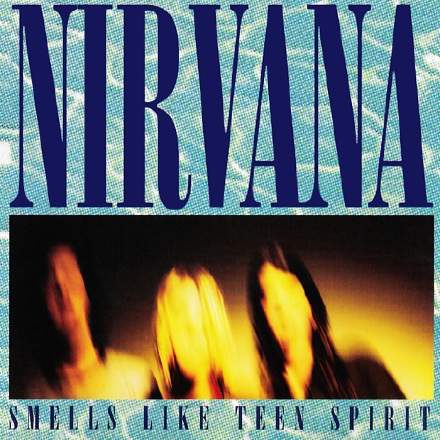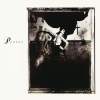
I’ve done a lot of moaning about songs based almost exclusively around a repeating four-chord pattern, but this one gets a pass from me for several reasons. For a start, the i-iv-III-VI pattern itself is far from a common one – we’re not just talking some variant on I-V-vi-IV or I-vi-ii-V here. On top of this, the harmonic rhythm is one of the many musical variables that are used to create such strong section differentiation between the lower-energy verses/prechoruses and the maximum-angst choruses – the verses/prechoruses use a straight two-beats-per-chord rhythm, whereas the choruses pull the second and fourth chords an eighth-note late (as enshrined in the song’s iconic opening guitar riff). In addition, the post-chorus turnaround (first heard at 1:30-1:38) does a good job of refreshing the harmonic palette with both its attention-grabbing new bII chord and its moments of faster chord-per-beat harmonic rhythm.
Much has been said, and justifiably so, about the raw power of Kurt Cobain’s vocal performance, but less focus has been given to some of the supporting vocal production techniques. During the verses, for instance, there’s clearly some kind of detune-based widening effect being used to make the voice appear bigger while there’s still lots of space available for it in the arrangement at that point. During the choruses, however, there’s little trace of this effect, which stands to reason where the opposition-panned distorted guitars are now taking over the mix’s width dimension and it’d seem counterproductive to smooth out Cobain’s ragged high-energy vocal delivery with a heavy modulation treatment. Notice also how the prechorus’s more phaser-like vocal effect is being subtly ridden up in level towards the end of the section as a way of building extra momentum into the start of the chorus.
The use of vocal double-tracking is well judged too, I think. It’s probably easiest to connect emotionally with a single singer, so this song sensibly avoids double-tracking during the verses, given that these sections deliver the most lyric development. And this also means that the obviously opposition-panned double-tracks of the prechorus provide a great source of section differentiation, as well as (like most vocal double tracks) an implicit encouragement for the audience to start singing along! When we reach the chorus, though, you can hear a delicate balance being struck. On the one hand, there’s still some double-tracking going on to thicken the vocal timbre and maintain a bit of that singalong energy; but on the other hand, the lead line and double track have both been panned centrally, with the double-track significantly lower in level, so that the double-track feels like more of a subliminal support, thereby returning some of the single-voice emotional authenticity and avoiding sanitising the basic vocal timbre’s rough edges by virtue of the inherently homogenising effect of the layering.
Other than the vocals, though, it’s probably the drums that most demand the average listener’s attention, and I’ve personally always been struck by their incredibly sharp-edged attack – so much so that the song earned itself a place on my very first mix-referencing playlist back in the late 90s as a counterpoint to most rock records of the day being emasculated in this respect by over-zealous loudness maximisation. In particular, the kick drum has a pretty brutal upper-spectrum beater click that slices effortlessly through the aggressive guitar distortion and also provides impeccable small-speaker translation. This is one of those few rock records where the kick drum scarcely loses any ground at all to the snare in the balance even on tinny little earbuds. Or, to put it another way: with a little bit of side-chain low-pass filtering I was able to get a gate triggering pretty reliably from this mix’s kick-drum hits, but trying to do the same with the snare was hopeless because the kick also delivers such strong upper-spectrum transients. To be honest, in fact, the drum sound is a bit too extreme in this regard for my taste, and even back in the day one of the reasons I referenced the track was as a way of ensuring I wasn’t pushing my own HF kick-drum spikes too far.
However, I’m probably wasting my breath telling you this, because you’ve probably never heard it. I’m sure you’ve heard the song, of course, but unless you’re a reactionary Gen X like me who still has a 30-year-old Nevermind CD, you’ve almost certainly been robbed of this iconic track’s true transient impact. You see, the CD version shows scarcely any evidence of mastering-stage peak limiting at all – by my count, only about a dozen drum peaks even reach the track’s -0.2dBFS digital ceiling, and the level variations of the other hits suggest that those didn’t trouble the limiter at all. But when I downloaded both versions of the song (the supposedly ‘original’ release version and the 2021 remaster) from iTunes for this critique, they’d clearly both been limited further, both losing around 4dB of peak headroom to clock in at -8dBLUFS (compared to my CD version’s -12dBLUFS loudness level). And the remaster was also inexplicably polarity inverted into the bargain!
Undeterred, I headed over to Spotify, figuring that surely any conscientious record company would have taken advantage of the loudness-normalised platform’s standardised 14dB headroom to deliver Dave Grohl’s transients to his adoring public in pristine condition. Not a chance. Roughly -9dBLUFS there, despite Spotify’s own published guidance to master tracks for upload at -14dBLUFS. I surfed over to Youtube next, where the song’s official video also lost a couple of decibels of headroom at around -10dBLUFS. So, if I’m reading these statistics correctly, that means that at least half of the US streaming market aren’t hearing the drum sound I’m hearing on the CD, even taking data-compression issues out of the equation.
Discarding my popped party balloon and leaving my dropped lollipop gathering lint, I decided to get serious and headed over to the high-resolution audio download site Qobuz instead, where I discovered to my excitement that not only were both original and remastered versions of the mix available at CD quality, but that the original version was also provided at 24-bit, 96kHz resolution!
Except that those are all mastered around -7dBLUFS.
What. The. Actual. F@#%?!
And that’s only the first of many questions I have. Why should it be so bloody difficult to listen to a classic, era-defining rock record in the form it was actually released? Shouldn’t we all be rioting (like the crowd in the music video!) about record companies silently retconning the production values of countless classic records, thereby brainwashing upcoming engineers’ with a distorted understanding of historic recording practices? (For other fairly egregious examples of this kind of thing, check out my critiques of Phil Collins’ 'In The Air Tonight'’ and Vera Lynn’s 'We'll Meet Again'.) Why the hell should any project-studio rock musician listen to mastering engineers whining on about the evils of peak-limiting when the industry establishment continues to deliver such a clear message that reduced headroom is actually preferable, a positive goal to be pursued even where playback headroom and file resolution present no dynamic-range restrictions at all? Could this stuff have anything to do with the rarely mentioned and rather inconvenient truth that peak-limiting can actually reduce a mix’s integrated loudness at mastering, and therefore deliver a volume boost even on loudness-normalised streaming platforms?
Now don’t get me wrong – I’m not some dynamic-range maven. I’ve always taken a very pragmatic approach to loudness processing, and I’d probably have pushed ‘Smells Like Teen Spirit’ to at least -7dBLUFS myself if it had been my mix! Crucially, though, this isn’t my mix, and it was mastered the way it was in 1991 to serve the actual creators of the mix at that time, so where’s the hurt in leaving it that way now that we’re supposedly in this brave new world of high-headroom, high-bandwidth streaming technology?










